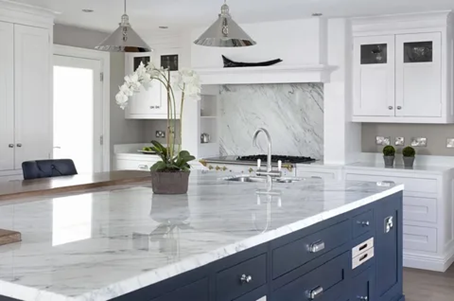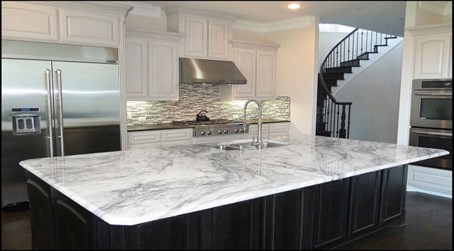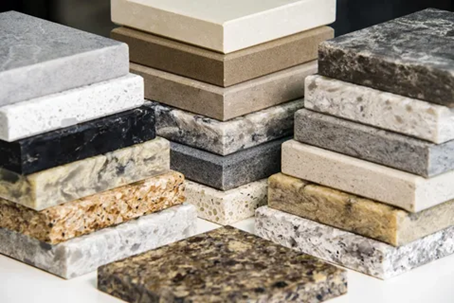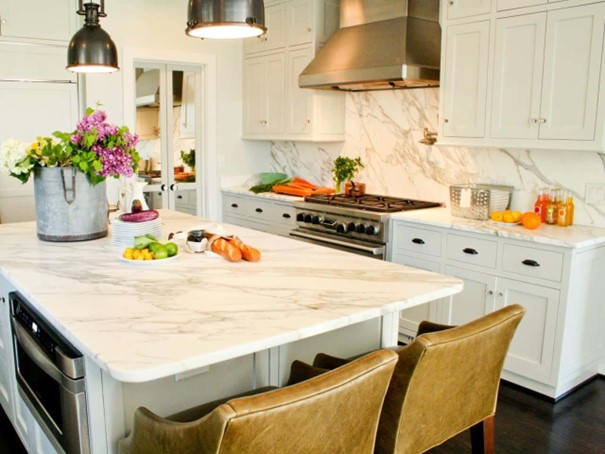Marble vs. Granite: Comparing the Popular Countertop
If you’re looking to add a new kitchen countertop, you may be wondering whether to install marble or granite. Both are popular materials that can look great, but there are some key differences to consider.
Understanding the Differences in Appearance
Whether you’re buying a new countertop or renovating your existing one, it’s important to know the differences between marble and granite. Both of these natural stones are durable and beautiful, but they have distinct appearances. You’ll need to choose the material that’s right for your project.
Marble is a sedimentary rock that formed naturally. It is created by a combination of high heat and pressure, which results in a smooth and veiny surface. Marble also incorporates other minerals like calcite.
Granite is an igneous rock. It’s formed from the solidification of magma deep within the earth. Once molten, granite is made up of silica, quartz, and mica. The resulting stone has a crystalline structure and is relatively strong.

Unlike granite, marble is softer. It absorbs water better and is less resistant to scratches and abrasions. However, it’s more prone to staining, especially from acidic liquids. Moreover, it’s vulnerable to hot cookware, which can dull its appearance.
Marble is also a good choice for shower and tub decks. It can be used for kitchen countertops, vanities, and flooring. It’s a popular choice for commercial kitchens, because it’s durable.
Marble is usually grayish or white, although it can also be dark. It can have large vein-like patterns that run through the slab. If you want to avoid any potential damage from water, you should use waterproofing agents.
Granite is a harder, more durable, and abrasion-resistant natural stone. But it’s also more porous and has a more variegated appearance.
Comparing Maintenance Requirements
Marble and granite have a similar appearance but differ in their maintenance requirements. Granite is more durable and requires less maintenance, while marble requires more care and attention.

Marble is a metamorphic rock, meaning that it has shifted under the heat and pressure of the Earth. The resulting stone is softer than granite, but it is also more porous. This means that liquids will penetrate into the marble. It is also more susceptible to stains.
Granite is a harder material that is more stain-resistant and less prone to breaking. However, the price of the stone is often higher for rarer colors and types.
Both granite and marble require sealing to prevent water and acidic substances from penetrating the surface. You should seal your granite every year or so, and your marble every 6 months to a year. Sealing will not protect your stone from etching, but it will help improve its resistance to stains.
Marble is more porous than granite, so it is easier for liquids to absorb into the stone. To avoid this, it is best to use a neutral PH cleanser.
Marble requires a special detergent to remove stains, and it must be sealed to prevent moisture. It can be damaged by hot cookware and acidic food. If you do find that your marble needs to be cleaned, it is best to clean it immediately.
Besides being more durable than granite, marble is also more resistant to scratches. Because of this, it is a better choice for entryways and other low-traffic areas.
Assessing Heat and Stain Resistance
When it comes to selecting a countertop material, assessing heat and stain resistance is important. Choosing a durable, low maintenance material can improve the value of your home. If you’re planning to upgrade your kitchen or bathroom, take a close look at granite and marble. They both offer unique advantages and disadvantages.
Granite is a hard, durable material that withstands high temperatures. It also has a smooth surface and a polished finish. This makes it a good choice for any kitchen.
Marble, on the other hand, is a soft stone that is more prone to scratches and chips. While it is relatively durable, it is not as resilient as granite.

Both granite and marble require special care. For example, marble needs to be sealed every six months. In addition, it is important to use a neutral pH cleaner for cleaning. Acidic cleaners can etch the surface.
Marble is not as durable as granite, which is why it isn’t recommended for kitchen countertops. To prevent damage, be sure to protect the countertop with a trivet or heat pad.
Granite is not as durable as marble, so it isn’t a good choice for a bathroom or kitchen countertop. It can chip and crack if subjected to heavy objects or heated bathroom equipment.
While marble and granite are both natural stones, they are very different. Marble requires sealing and care, while quartz is a non-porous, non-staining material that requires minimal maintenance.
Evaluating Environmental Impact
Marble and granite are both used in the construction industry. Depending on the specific application, both have their own respective environmental effects. It is important to evaluate their carbon footprints before deciding to use them in a concrete mix.
In addition to their durability properties, marble and granite are known for their aesthetic qualities. However, there are many environmental issues associated with the production of marble and granite. Granite is considered to have a high carbon footprint, while marble is a non-renewable resource.
In the slurry field, the research was evaluated with different cementitious materials, such as pumice, diatomite, and slag. Marble waste was evaluated using a similar slurry process to determine its effects on concrete properties.

Marble waste had a better Young’s modulus and compressive strength than limestone aggregates. Using marble waste as a partial replacement of ordinary Portland cement (OPC) in a concrete mixture had no negative effects on the performance of the concrete mix.
Other studies showed that mixes made with marble waste had higher mechanical properties than limestone aggregates. The maximum gain was achieved when the substitution level was about 10%.
Marble waste can be considered as an alternative to river sand or crushed rock dust as an aggregate. This can also help reduce the amount of CO2 emissions in the mining and cement industries.
A study on the substitution of limestone aggregate with marble waste was conducted by Hebhoub et al. The results revealed that the compressive strength of the mixtures remained comparable to the control concrete, but a slight reduction was observed in fresh bulk density.
Considering the Look and Feel of Your Kitchen
When choosing a countertop, you should consider the looks and functions of your kitchen. In particular, the color of your countertop is important because it sets the tone for the rest of the room. Also, the color you choose should match the color of your cabinets.
There are many types of countertop materials available to choose from, so you’ll want to find one that suits your needs. You’ll need to look at things such as the amount of money you have to spend, the size of your kitchen, and the type of use you plan to put the countertop to.
One of the most popular types of countertops are granite. It is heat-resistant and easy to maintain. However, it isn’t for everyone.
Another choice is marble. Marble is a luxury material that is porous, making it a bit more difficult to maintain than its quartz counterpart.

The classic black countertop is an effective option. Even though it may not be the most stylish choice, it’s an excellent option for most situations.
Granite is also an impressive countertop material. Depending on the cut you get, you’ll have options ranging from a sleek, clean look to a dramatic, yet subtle, appearance.
Butcher block is another trendy counter option. It is a great way to create a chef-inspired look. A stainless steel countertop can be paired with a butcher block style.
The most important factor to consider when choosing a countertop is the material. Countertops can be made from wood, tile, or granite. Each material has its own advantages and disadvantages. Some will scratch easily and others require regular cleaning.
Popular Marble and Granite Colors
There are many types of marble and granite colors available for your home. From bright whites to blacks, you will find plenty of choices to match your style. These exotic countertop colors are striking reminders of Mother Nature.
For kitchen countertops, the best choice is usually a color that complements your cabinetry. White is a classic choice for this type of material. You can match it with taupe, oak, or other wooden surfaces. It will also pair well with stainless steel appliances.
Almond Gold is another popular choice for the neutral palette. This material has an earthy nut brown and umber hues that blend with traditional and contemporary design aesthetics. The amber tinges in the material give it a warm, layered look.

If you’re looking for a darker stone for your kitchen, you may want to consider Black Galaxy. This granite is available in a variety of shades, from light gray to dark black.
Another great choice is Nordic Black. It has gray flecks, making it similar to cracked marble. It works well with stainless steel appliances and other lighter granite colors.
Brass Blue is another option. It is a medium-variation stone that features small, sharp black flecks. Usually, this stone has pretty veining.
White Primata is an excellent choice for a midrange kitchen. It is imported from Brazil and is relatively affordable. With its modern feel, it pairs well with other high-end materials.
Contact us immediately to choose the most suitable one for you from our remodeling project in which our marble or granite kitchen countertops are located with the assurance of Granite Expo.
